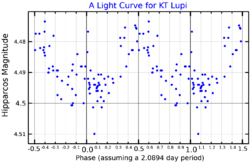Astronomy:KT Lupi
| Observation data Equinox J2000.0]] (ICRS) | |
|---|---|
| Constellation | Lupus |
| Right ascension | 15h 35m 53.24806s[2] |
| Declination | −44° 57′ 30.1982″[2] |
| Apparent magnitude (V) | 4.55[3] (4.66 + 6.62)[4] |
| Characteristics | |
| Spectral type | B3 V + B6 V[5] |
| B−V color index | −0.175±0.003[3] |
| Variable type | Be[6] |
| Astrometry | |
| Radial velocity (Rv) | +6.5±2.8[7] km/s |
| Proper motion (μ) | RA: −20.53[2] mas/yr Dec.: −21.23[2] mas/yr |
| Parallax (π) | 7.62 ± 0.43[2] mas |
| Distance | 430 ± 20 ly (131 ± 7 pc) |
| Absolute magnitude (MV) | −1.03[3] |
| Details | |
| KT Lup A | |
| Mass | 5.9±0.1[8] M☉ |
| Radius | 3.00±0.06[9] R☉ |
| Luminosity | 794+791 −396[10] L☉ |
| Surface gravity (log g) | 3.50±0.04[9] cgs |
| Temperature | 18,400±184[9] K |
| Rotational velocity (v sin i) | 30±0.6[9] km/s |
| Age | 21.0±10.6[8] Myr |
| KT Lup B | |
| Mass | 2.79[11] M☉ |
| Other designations | |
| Database references | |
| SIMBAD | data |
KT Lupi is a visual binary star[5] system in the constellation Lupus. It is visible to the naked eye with a combined apparent visual magnitude of 4.55.[3] As of 1983, the pair had an angular separation of 2.19″±0.03″.[10] Based upon an annual parallax shift of 7.6 mas[2] as seen from Earth's orbit, it is located 430 light-years from the Sun. The system is moving further from the Earth with a heliocentric radial velocity of +6.5 km/s.[7] It is a member of the Lower Centaurus–Crux sub-group of the Scorpius–Centaurus association.[5]
The primary, component A, is a variable Be star,[6] with the variation being modulated by rotation.[13] It is visual magnitude 4.66[4] with a stellar classification of B3 V,[5] matching a B-type main-sequence star. Hiltner et al. (1969) gave a class of B3 IVp,[14] which is still used in some studies.[8][9][10] It is a helium-weak chemically peculiar star showing an enhanced silicon patch near the equator and a silicon-weak region close to the pole.[10] The star is about 21 million years old with nearly six[8] times the mass of the Sun and three times the Sun's radius.[9] It is radiating roughly 794[10] times the Sun's luminosity from its photosphere at an effective temperature of 18,400 K.[9]
The secondary companion, component B, is of magnitude 6.62[4] with a class of B6 V.[5] It has 2.79 times the Sun's mass.[11]
References
- ↑ "Hipparcos Tools Interactive Data Access". ESA. https://www.cosmos.esa.int/web/hipparcos/interactive-data-access.
- ↑ 2.0 2.1 2.2 2.3 2.4 2.5 van Leeuwen, F. (2007), "Validation of the new Hipparcos reduction", Astronomy and Astrophysics 474 (2): 653–664, doi:10.1051/0004-6361:20078357, Bibcode: 2007A&A...474..653V.
- ↑ 3.0 3.1 3.2 3.3 Anderson, E.; Francis, Ch. (2012), "XHIP: An extended hipparcos compilation", Astronomy Letters 38 (5): 331, doi:10.1134/S1063773712050015, Bibcode: 2012AstL...38..331A.
- ↑ 4.0 4.1 4.2 Eggleton, P. P.; Tokovinin, A. A. (2008), "A catalogue of multiplicity among bright stellar systems", Monthly Notices of the Royal Astronomical Society 389 (2): 869, doi:10.1111/j.1365-2966.2008.13596.x, Bibcode: 2008MNRAS.389..869E.
- ↑ 5.0 5.1 5.2 5.3 5.4 Chen, Christine H. et al. (September 2012), "A Spitzer MIPS Study of 2.5-2.0 M⊙ Stars in Scorpius–Centaurus", The Astrophysical Journal 756 (2): 24, doi:10.1088/0004-637X/756/2/133, 133, Bibcode: 2012ApJ...756..133C.
- ↑ 6.0 6.1 Samus', N. N; Kazarovets, E. V; Durlevich, O. V; Kireeva, N. N; Pastukhova, E. N (2017), "General catalogue of variable stars: Version GCVS 5.1", Astronomy Reports 61 (1): 80, doi:10.1134/S1063772917010085, Bibcode: 2017ARep...61...80S.
- ↑ 7.0 7.1 de Bruijne, J. H. J.; Eilers, A.-C. (October 2012), "Radial velocities for the HIPPARCOS-Gaia Hundred-Thousand-Proper-Motion project", Astronomy & Astrophysics 546: 14, doi:10.1051/0004-6361/201219219, A61, Bibcode: 2012A&A...546A..61D.
- ↑ 8.0 8.1 8.2 8.3 Tetzlaff, N. et al. (January 2011), "A catalogue of young runaway Hipparcos stars within 3 kpc from the Sun", Monthly Notices of the Royal Astronomical Society 410 (1): 190–200, doi:10.1111/j.1365-2966.2010.17434.x, Bibcode: 2011MNRAS.410..190T.
- ↑ 9.0 9.1 9.2 9.3 9.4 9.5 9.6 Arcos, C. et al. (March 2018), "Stellar parameters and H α line profile variability of Be stars in the BeSOS survey", Monthly Notices of the Royal Astronomical Society 474 (4): 5287–5299, doi:10.1093/mnras/stx3075, Bibcode: 2018MNRAS.474.5287A.
- ↑ 10.0 10.1 10.2 10.3 10.4 Briquet, M. et al. (January 2007), "Discovery of magnetic fields in three He variable Bp stars with He and Si spots", Astronomische Nachrichten 328 (1): 41–45, doi:10.1002/asna.200610702, Bibcode: 2007AN....328...41B.
- ↑ 11.0 11.1 Kouwenhoven, M. B. N. et al. (October 2007), "The primordial binary population. II. Recovering the binary population for intermediate mass stars in Scorpius OB2", Astronomy and Astrophysics 474 (1): 77–104, doi:10.1051/0004-6361:20077719, Bibcode: 2007A&A...474...77K.
- ↑ "KT Lup". SIMBAD. Centre de données astronomiques de Strasbourg. http://simbad.u-strasbg.fr/simbad/sim-basic?Ident=KT+Lup.
- ↑ Briquet, M. et al. (January 2004), "He and Si surface inhomogeneities of four Bp variable stars", Astronomy and Astrophysics 413: 273–283, doi:10.1051/0004-6361:20031450, Bibcode: 2004A&A...413..273B
- ↑ Hiltner, W. A. et al. (July 1969), "MK Spectral Types for Bright Southern OB Stars", Astrophysical Journal 157: 313, doi:10.1086/150069, Bibcode: 1969ApJ...157..313H
 |


